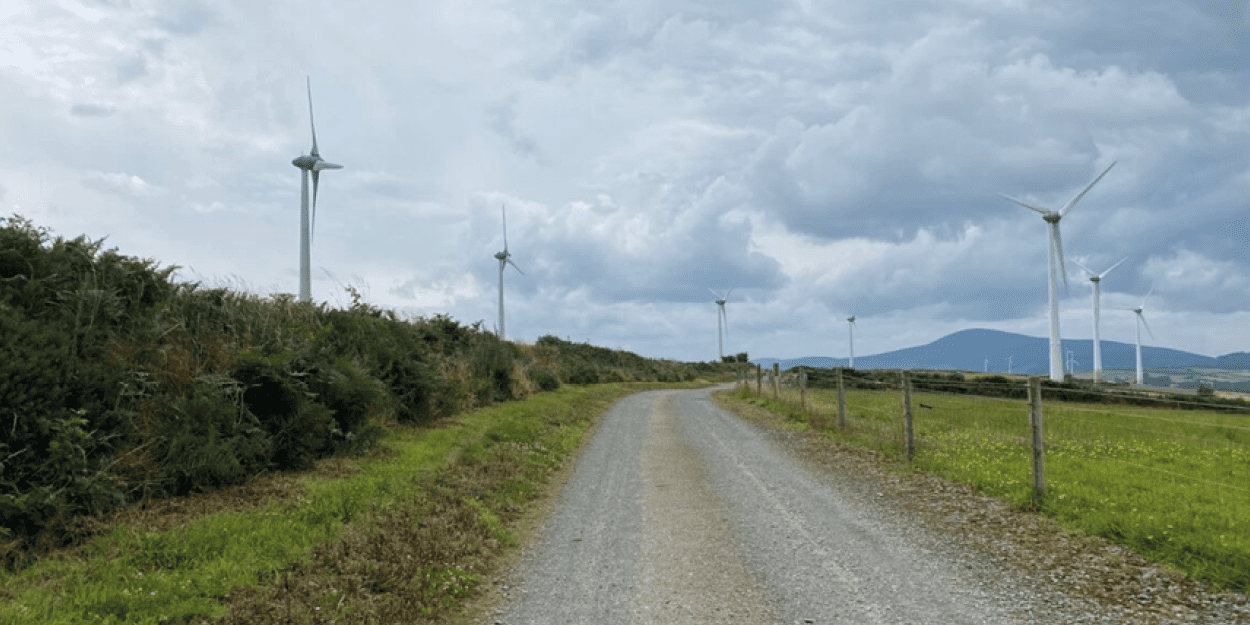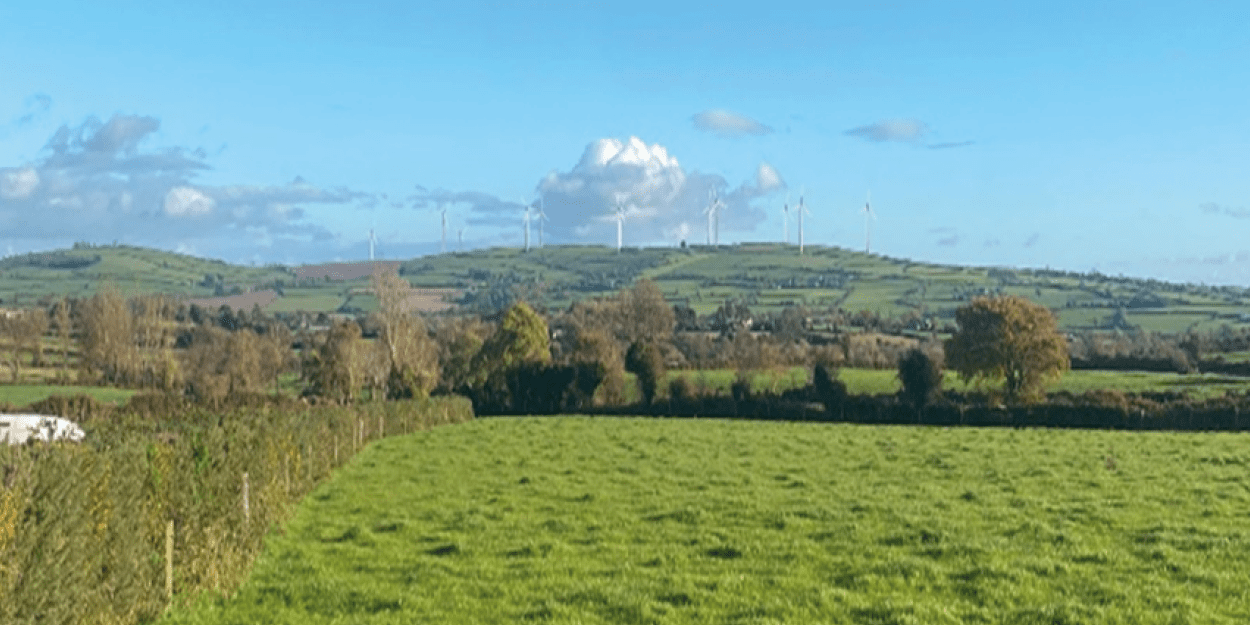Planning permission granted for an operational lifetime extension at Castledockrell Wind Farm
MKO welcomes the recent decision by An Coimisiún Pleanála to grant planning permission for the extension of the operational lifetime of the Castledockrell Wind Farm, located in Co. Wexford. The 11 wind turbines at Castledockrell now have permission to operate for a further 20 years, continuing to assist in achieving Ireland’s climate and sustainability targets. Retaining Ireland’s existing wind energy capacity, through extension of life and repowering applications, is crucial to achieve the CAP 25 target of reaching an installed capacity of 9GW of onshore wind energy by 2030.
With a capacity of 25.3 MW, the Castledockrell Wind Farm will continue to supply clean, renewable electricity to the national grid. Castledockrell Wind Farm will produce enough electricity to supply the equivalent of approximately 15,000 homes per year, approximately 27% of all houses in Co. Wexford. MKO led a multidisciplinary team which provided environmental surveying and expertise, planning advice, project management and the preparation of the planning application.


Planning news
National Housing Plan 2025-2030
The Department of Housing, Local Government and Heritage published the long-awaited new housing plan ‘Delivering Homes, Building Communities: An Action Plan on Housing Supply and Targeting Homelessness’, which aims to speed up the delivery of new housing and to tackle homelessness. This new plan seeks to significantly accelerate delivery through regulatory reform, tax incentives and the largest ever capital investment in the history of the State – €275 billion in infrastructure over ten years through the National Development Plan.
Some of the key measures addressed in the new plan include:
- The delivery of 300,000 new homes, which included 72,000 social homes and 90,000 affordable housing supports, by the end of 2030.
- Delivering an average of 12,000 new social homes every year over the lifetime of the plan.
- Providing 15,000 affordable supports annually through the ‘Starter Homes’ programme.
- The investment of record-level funding into critical infrastructure such as wastewater, electricity capacity, and roads to support new housing developments €24.3 billion for the transport sector
- A series of measures to unlock apartment delivery, including a reduction in the VAT rate, an exemption from corporation tax for cost rental homes, an enhanced corporation tax deduction, and changes to Planning Design Standards for Apartments
- Establishing rent controls on a national basis and introducing legislation to provide stronger protections for tenants.
- Dedicated capital funding of €100 million in 2026 for the acquisition of second-hand properties to support the exit of families who have been longest in homeless emergency accommodation and the Housing First programme.
- €3.5 billion in equity earmarked for energy projects with ESB Networks and EirGrid Group
- €12.2 billion secured for water and wastewater services
- €24.3 billion for the transport sector
- A series of measures to unlock apartment delivery, including a reduction in the VAT rate, an exemption from corporation tax for cost rental homes, an enhanced corporation tax deduction, and changes to Planning Design Standards for Apartments.
- Establishing rent controls on a national basis and introducing legislation to provide stronger protections for tenants.
- Dedicated capital funding of €100 million in 2026 for the acquisition of second-hand properties to support the exit of families who have been longest in homeless emergency accommodation and the Housing First programme
Minister O’Brien welcomes decision to publish the Electricity (Supply) (Amendment) Bill 2025
The Electricity (Supply) (Amendment) Bill 2025 was published on 29 October 2025 by the Department of Climate, Energy and the Environment. Under the Bill, the government is proposing to invest €1.5 billion in ESB Networks over the next five years. Additionally, the statutory borrowing limit of ESB is to be raised from €12 billion to €17 billion to support its large-scale infrastructure programme. The investment will enable ESB Networks’ plan to build and upgrade significant parts of the electricity network: approximately 181 km of new overhead lines, 319 km of new underground cables, nearly 70 new or upgraded substations, and some 50,000 pole replacements.
This infrastructure is aimed at improving resilience of Ireland’s onshore electricity system, accommodating projected demand growth (forecast at around 50 % by 2035), supporting housing delivery and renewable energy roll-out, and helping shield the network from severe weather events.
Renewables news
Biggest ever onshore wind pipeline to be announced at Wind Energy Expo 2025
At the recently held Wind Energy Expo 2025 in Dublin, attention focused on the remarkable scale of Ireland’s onshore wind project pipeline, which now exceeds 14,000 MW. This marks a milestone for the sector and underlines its growing role in the country’s energy transition. Industry leaders emphasised that onshore wind remains Ireland’s most affordable source of new power, and that expanding this pipeline will reduce dependency on imported fossil fuels while shielding households and businesses from volatile global energy markets. During the Expo, which featured over a hundred exhibitors from both Ireland and abroad, and included strong international participation from Belgium, the Netherlands and the UK, attendees were reminded that infrastructure and supply-chain investment are now firmly targeted at this growing market. The launch of a government backed “Clearing House” for offshore renewables, and the forthcoming auction for the 900 MW Tonn Nua site off Waterford, signals the complementary importance of offshore wind, while onshore projects remain central to near-term goals. Noel Cunniffe, CEO of Wind Energy Ireland, called for the government to raise national onshore wind targets to 11,000 MW by 2035 and 15,000 MW by 2040, an ambitious ask but one that reflects confidence in the sector’s capacity to deliver. The message resonated clearly: now is the time for bold policy and decisive action if Ireland is to harness its wind asset to the full and deliver lower-cost clean energy at scale.
Policy and legislation
Implementation of the new Planning Act (October 2025)
The latest phase of the Planning and Development Act 2024 came into effect on the 2nd of October 2025, marking a major step in the rollout of Ireland’s new planning system. The changes introduced this month focus on strengthening the national and regional planning framework and improving consistency across all levels of the planning process. From October, the Act formally gives legal standing to the National Planning Framework and the Regional Spatial and Economic Strategies. This ensures that local development plans must now align more closely with national and regional objectives. The commencement also replaces the old Section 28 Ministerial Guidelines with a new system of National Planning Statements. These statements will set out clear planning priorities for the country and must be followed by local authorities when preparing or reviewing development plans. Together, these updates bring greater clarity and structure to the hierarchy of planning in Ireland. They are intended to make the system more transparent and better coordinated, ensuring that decisions at local level are consistent with broader national and regional goals.
Public consultations
Louth County Council
Issues Paper for the Pre-Draft Stage of the Louth County Development Plan 2027-2033. Public Consultation Period: 23rd September – 21st November 2025.
Kildare County Council
Proposed Variation No. 2 – Newbridge Settlement Plan – of the Kildare County Development Plan 2023 – 2029. Public Consultation Period: 17th September – 16th October 2025.
Meath County Council
Meath County Development Plan 2027-2033 Pre-Draft Strategic Issues Paper. Public Consultation Period: 23rd September – 18th November 2025.


